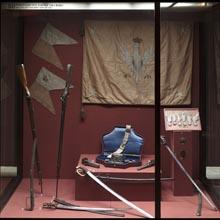
1. Lance-pennons
Poland, 1863
2. Standard of wołyń cavalry regiment
Poland, 1863
Gift of Józef Büttner
3. Percussion carbine used during the january insurrection
Austria, Lorenz system, model 1862
Rifled, calibre: 13,4 mm
Gift of Witold Mieszkowski, 1935
4. Percussion carbine used during the january insurrection
Austria, 1852
Rifled, calibre: 18 mm
Gift of Justyn Sokulski, 1938
5. Cavalry sabre Turkish blade from the 17th century, fittings Polish from early 19th century
Gift of the Hutten-Czapski family, 1903
6. Cavalry sabre with sheath
Poland, Krakow, manufacture of Ignacy Höfelmajer, 1862
Gift of Konrad Korczak Hubicki, 1904
7. Karol Kalita “Rębajło’s” sabre with sheath
Russia, about 1863, fittings of model 1826
Gift of Prof. Adam Łobaczewski, 1920
Blade encrusted with gold on either side with inscriptions: „W Imię Boga dobądź szabli A moskali wezmą diabli" (In the Name of God draw a sabre and Russians go to hell), on one side, and: „Pod Twoje Obrone Uciekamy Się / Od przyjaciół Rembajle 1864 r." (We take a shelter under Your protection / To Rembajło from friends) on the other
8. Agaton Giller’s double-barrelled percussion pistol
Germany or Italy, mid 19th century
Rifled, calibre: 19 mm
9. Colonel Edmund Różycki’s case with cartridge-pouch, belt with straps and sword-knot
Poland, 1863
in the case:
Ribbon from the january insurgent’s cap
Poland, 1863
Ribbon from the january insurgent’s cap
Poland, 1863
Medal of the january insurrection veterans
Poland, Lvov, after 1864
10. Pin-lock pistol
Poland, Krakow, manufacture of Ignacy Höfelmajer, about 1860
Rifled, calibre: 9 mm
Gift of Jan Wentzl, 1938
11. Aigrettes for lancers czapkas of the Taczanowski’s regiment
Poland, 1863
Gift of Anastazja Zarębina, 1904
12. Plate for a cartridge-pouch
Poland, 1863
13. Cockade for a shako
Poland, 1807-1814
14. Cavalry sabre with sheath
Poland, about 1863
exposition: Gallery „Arms and Uniforms in Poland",
The Main Building, 1, 3 Maja Av.
key: Edged weapons <<<
The collection of Polish and European weapons belonging to the National Museum in Krakow includes nearly five hundred examples of historical swords, sabres, karabelas, rapiers, épées, cutlasses and bayonets. The oldest are Celtic and Roman swords from the Bronze Age and early medieval swords found in the territory of Poland, including finds from Reczyn and from Michrów. Some unique specimens include executioners’ swords from the fifteenth to the seventeenth centuries, with a Cracovian example from the fifteenth century that is said to have been used to behead famed Polish rebel Samuel Zborowski. The most valuable items in the collection are thought to be the exceptionally rare Polish sabres and karabelas dating from the sixteenth to the twentieth centuries. Among them there is a set of seventeenth century Hungarian-Polish and Hussar sabres, the famed Zygmuntówka and Batorówka types, eighteenth and nineteenth-century karabelas worn with national costumes, and sabres used in the uprisings for national independence and in the Polish Legions, as well as commemorative swords dedicated to important national events. Inestimable in value are the sabres that were once the property of distinguished historical figures, such as Stanisław Chomentowski’s commemorative sabre from the 1713 mission to Turkey, the sabre of General Piotr Jaźwinski, which he used in the Kosciuszko insurrection, and the commemorative sabres of General Jan Skrzynecki from the period of the November Insurrection and his service in the Belgian army, as well as the sabre of General Henryk Dembiński from the Lithuanian expedition in May 1831. Among the Polish épées in the collection, the most valuable are those connected with well-known historical figures – Generals Franciszek Paszkowski, Józef Chłopicki and Jan Skrzynecki. Some of the more valuable Cracovian items are the karabelas and sabres from the workshop of Ignacy Höfelmajer, the 19th century swordsmith and gunsmith who had his shop in the Sukiennice. The weaponry of other European countries is represented by such exhibits as the extensive collection of rapiers, parrying daggers, Venetian schiavonas, and Scottish backswords and épées . There are also numerous hunting weapons, including cutlasses and knives – with an extraordinarily valuable cleaver with hilt, on which the calendar for 1528 is etched. The collection is completed by a small set of bayonets. The rich collection of polearms and impact weapons is made up of halberds, pikes, spontoons, partisans, and magnificent Polish maces, both for battle and for ceremonial purposes, standing out among which is a unique pure gold mace which once belonged to hetman Stanislaw Jabłonowski.
Piotr Wilkosz












